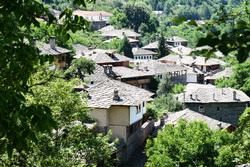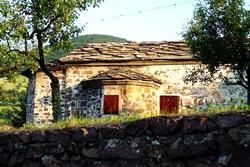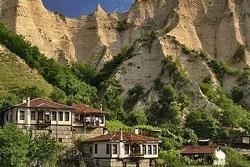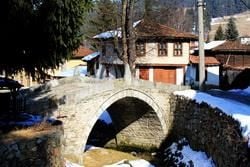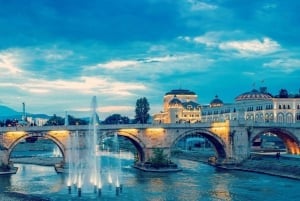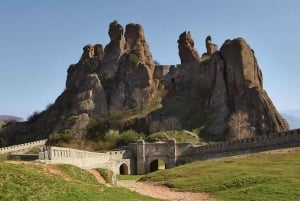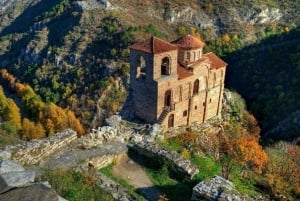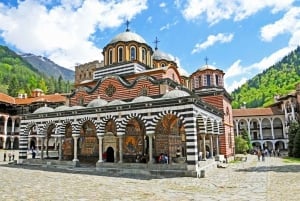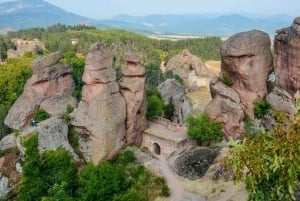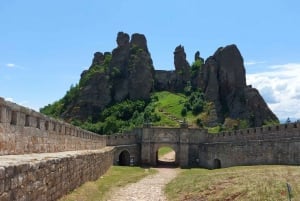Culture and Tradition near Sofia
Melnik:
With a population of just 350 people, Melnik is the smallest town in Bulgaria. It is located in the southwestern part of the country, 170 km away from the capital city. What makes this town so special is its architecture. Almost every building there is a monument of culture from the Bulgarian National Revival Period showing off impressive wall paintings, wood carvings and stained glasses. The 19th-century history museum and Kordopulov House, erected in 1754, are perhaps the two best examples.
The region is also famous for its vineyards so when grabbing a bite in one of the many traditional taverns there (some of which are situated in caves, by the way), make sure you order a glass or two of the strong, dark-red local wine. The rock pyramids overhanging the small town are another landmark that attracts many tourists every year.
Rozhen Monastery, the biggest monastery in
Pirin Mountain, lies just 5 km away from Melnik.
Kovachevitsa and Leshten:
The picturesque villages of Kovachevitsa, an architectural reserve, and Leshten are situated just a couple of kilometres to the northeast of Melnik in the western part of the
Rhodope Mountains. The first and most important thing you will notice about them is that they do not obey the laws of time. They have stopped somewhere in the past and refuse to move forward. And in the good sense. Their stone and wooden houses and narrow paved alleys haven’t yielded to the pressure of modernity and have kept the original atmosphere of 19th-century Bulgaria. Tourists who choose to visit these villages should bear in mind that they won’t find any fancy hotels or restaurants there… only traditional guest-houses and taverns that date back to the National Revival Period. Still, no matter how impressive their architecture is, these villages would have been nothing without their inhabitants. Every Saturday they set up street markets where one can hear all their interesting stories and buy the most yummy wild berries and mushrooms or get the nicest pair of hand-knitted woolen socks or mittens.
Chiprovtsi:
Wedged into an attractive valley in Western Stara Planina (Old Mountain), 130 km northwest of Sofia, Chiprovtsi is a small town with rich past and one important idiosyncrasy: it is among the few cultural centres in Bulgaria where carpet weaving is still widely practiced and perfected. The Chiprovtsi carpets have attained worldwide popularity thanks to their original designs and special production methods. They are woven on vertical looms and come in various forms that include many different stylized patterns and colours. According to traditions, wool and cotton are the two materials that are used most often for their production. Their exquisiteness has helped them become one of the country’s most easily recognized national symbols.
Koprivshtitsa and surroundings:
Koprivshtitsa is a tender symphony of nature, colour and history. The rows of houses built in the characteristic style of the National Revival Period, the folklore festivals and the rich cultural heritage have all helped the town become one of the most important ethnographic centres in Bulgaria. It was founded in the 14th century as a small cattle farming settlement but grew in importance during the Ottoman Rule when the citizens’ perspective gradually changed and they started engaging in many social and cultural activities. This was best reflected through the construction of some of the most mesmerizing architectural landmarks in the country such as the 19th-century Lyutov and Oslekov Houses. Koprivshtitsa was also an important revolutionary centre in the years before the liberation of the country from the Ottomans and provided shelter to some of the major figures of the Bulgarian resistance. It was also the place where the notorious April Uprising of 1876 was declared that eventually led to the Russo-Turkish War (1877-1878). Today many of the houses from that period have been transformed into ethnographic museums where one can see the most exquisite house decorations and woodcarvings and learn more about the customs and traditions of 18th and 19th-century Bulgarians. Koprivshtitsa is situated in the central part of the country, 100 km east of Sofia.
What was said about Koprivshtitsa is also completely true of its surrounding towns and villages. They all carry the characteristic features of Revival Period Bulgaria and have given birth to some of the most renowned writers, poets and social activists in the country’s history. The most famous among them are Sopot, Karlovo, Kalofer and Klisura.
Kazanlak:
The town of Kazanlak, located 100 km east of Koprivshtitsa, is often referred to as the Rose Valley capital because this is where the country’s finest roses are grown and where the world-famous Bulgarian rose oil is produced. Every year the town celebrates the Day of the Rose on which the citizens and guests of Kazanlak take part in many different rose-related fun activities and happenings such as the Queen Rose beauty contest, the Mini Miss children's beauty pageant and the Youth of the Balkans International Folklore Festival.
Photos by M.Marincheva, D.Dimitrov


